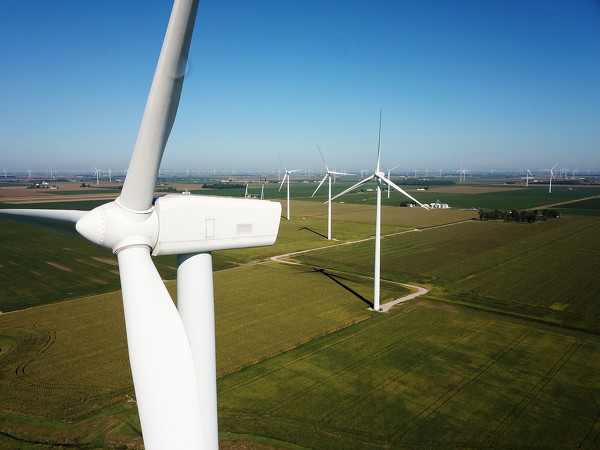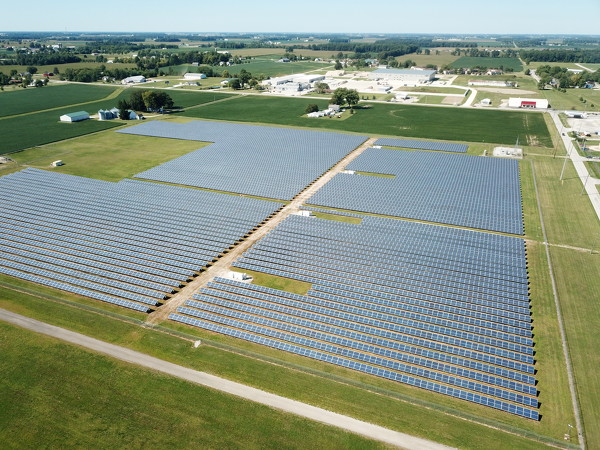Saturday, September 10th, 2022
Is answer blowing in the wind?
Commissioners to decide on solar, wind energy
By William Kincaid

Photo by Ryan Snyder/The Daily Standard
Wind turbines of the 304-megawatt Blue Creek Wind Farm in Van Wert County dot the horizon. New maps are being drawn that will restrict such developments in incorporated areas of Mercer County.
CELINA - The future of Mercer County's landscape is in the hands of county commissioners who will determine if and where certain sized wind farms and solar facilities can be constructed or significantly modified in unincorporated areas.
At present they appear to be leaning toward banning such projects in most of the unincorporated areas of Mercer County.
Commissioners this week scheduled a non-voting, public session to educate and seek community input on Ohio Senate Bill 52, which provides for localized regulation of renewable energy generation stations.
The session will be held at 7 p.m. Sept. 29 in the first floor conference room of the Central Services Building at 220 W. Livingston St., Celina.
Commissioners under the legislation that took effect Oct. 11, 2021, are authorized to regulate certain renewable energy generation facilities by designating all or parts of unincorporated areas as restricted, according to county documents. They have no such regulatory authority in incorporated villages and the city of Celina.
After conferring with trustees from 14 townships, commissioners have drafted preliminary maps designating unincorporated areas where construction of wind farms and solar facilities would be prohibited.
As the maps now stand, construction of wind farms would be prohibited in all unincorporated areas except in Jefferson Township. Also, construction of solar facilities would be permitted only in the unincorporated areas of Granville, Marion and Jefferson townships.
However, those preliminary maps are subject to change based on public comments voiced at or submitted at and after the Sept. 29 session at the Central Services Building.
If commissioners choose to adopt a resolution designating restricted areas, the legislation would take effect 30 days later. During the 30-day window, 8% of county voters may petition for a referendum to challenge commissioners' designations at the ballot box.
Renewable energy facilities pertains to large solar facilities, economically significant wind farms and large wind farms.
Under Ohio Revised Code, large solar facilities are defined as having panels and facilities with a single interconnection to the electric grid under the jurisdiction of Ohio Power Sitting Board (OPSB) and capable of operation at a capacity of 50 megawatts or more.
Economically significant wind farms are defined as having wind turbines and associated facilities with a single interconnection to the electric grid and capable of operation at an aggregate capacity of between 5 and 49 megawatts.
Not included are wind farms in operation on June 24, 2008, and facilities with one or more wind turbines that provide electricity to a single customer at a single location and are designed for an aggregate capacity of less than 20 megawatts, according to a manual published by County Commissioners Association of Ohio (CCAO).
Large wind farms are defined as electric generated plants consisting of wind turbines and associated facilities with a single interconnection to the electric grid under jurisdiction to OPSB and capable of operating at a capacity of 50 megawatts or more.

Photo by Ryan Snyder/The Daily Standard
Mercer County commissioners will decide the future of solar facilities in the area. The plant pictured here west of Celina can generate 5 megawatts of electricity.
County commissioners have two options in which to move forward. They can either proactively ban or establish exclusionary zones for wind and solar projects or take the reactive approach by considering each individual project on a case-by-case basis, county documents show.
"The Board can take a Proactive Approach and declare certain parts of the county off-limits to renewable projects," the documents state. "If an area is not restricted, the Board can take a Reactive Approach and deny requests from developers for individual projects."
Furthermore, under the reactive approach commissioners may adopt a resolution to either prohibit construction or limit the geographical scope of a proposed renewable energy project. The decision would not be subject to a voter referendum.
County commissioners aim to take the proactive approach by deciding once and for all, barring a voter referendum, which, if any, unincorporated areas renewable energy generation facilities may be built.
CCAO recommends county commissioners consider several factors before rendering a decision, among them the impacts on revenue and environment.
"Allowing development and agreeing to a PILOT (Payment In Lieu Of Taxes) payment may provide greater and more stable revenue than the alternative land uses," the CCAO manual reads. "While qualified energy projects have certain environmental requirements they must comply with, commissioners still may want to evaluate the environmental impact potential projects could cause, and the long-term impact on farmland from various alternative land uses."
At least 10 Ohio counties have moved to ban wind and solar projects, county documents show.
Auglaize County commissioners in late April voted to completely restrict development of economically significant wind farms and solar facilities in all unincorporated areas of Auglaize County, citing in a resolution "numerous impacts on users and property owners in vicinity of such developments."
Auglaize County commissioners also considered "potential impacts of development as well as interests of property owners in making their land available for development," per the resolution. Their decision was reportedly informed by feedback from all 14 counties.
In mid-March, Tony Zartman, deputy director of programs and operations with the conservative Ohio Land & Liberty Coalition, asked Mercer County commissioners to keep an open mind about supporting wind and solar projects in the county.
Landowners, local governments and schools have all benefited from much needed revenue brought in from renewable energy projects, Zartman had said.
"The land and liberty coalition, we promote green energy because as conservatives we know that we need to build energy production facilities in this state. We're using more and more electricity every day, and the answer to our high gas prices is to buy electric cars," he had said. "We're going to have to be able to produce that electricity."
Zartman also pointed out the coalition's support of property rights.
"We believe property owners should have the ability to make decisions for their family, for their operations the way they see fit as long as it's not injuring anybody personally," he had said.
Responding to Zartman, commissioner Jerry Laffin had noted that several years ago a group of school district superintendents and other officials voiced opposition to PILOT payments, saying they believed renewable energy production should be taxed at normal rates.
Laffin also alluded to opposition to wind turbines that formed about 12 years ago in southern Mercer County in part to concerns about how turbines would alter the landscape.
In 2010 and 2011, wind energy company NextEra proposed a large wind turbine farm to be located in the southern portion of Mercer County. By the spring of 2011, the project was abandoned due to overwhelming objection from area residents.
NextEra Energy Resources announced it was pulling the plug on a locally-proposed wind farm project out of respect for the area's rich religious history.
Company representatives at the time told the newspaper they changed their minds about constructing 40 to 70 wind turbines in the region after learning how much residents value the southern Mercer County-based "Land of the Cross Tipped Churches."
The Land of the Cross Tipped Churches highlights the roots of Catholicism in the area and in 1979 was added to the National Register of Historic Places. The tourist attraction includes dozens of churches, former convents, schools and rectories, as well as cemeteries and other sites across Mercer, Auglaize, Darke and Shelby counties.
More recently, wind turbines that had been proposed in northern Mercer County were also met with strong opposition from people who live there, Laffin had said.
Commissioner Greg Homan also at the March meeting weighed in on the notion of renewable energy production in Mercer County, saying he believes there's community apprehension and resistance to the type of large developments that Zartman had referenced.
There was much opposition expressed years ago and Homan had said he doesn't believe that anything has changed significantly since then.
Laffin had added that as an agricultural county, farmers want to use every inch of land they own to farm.




